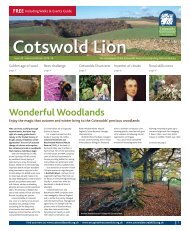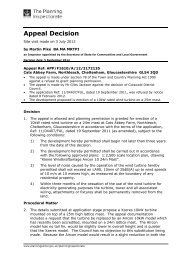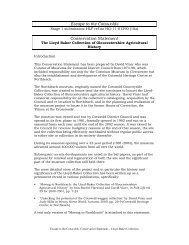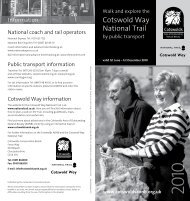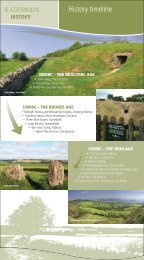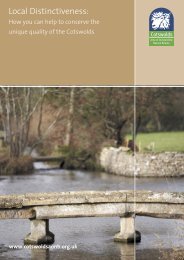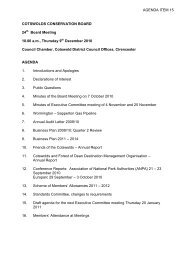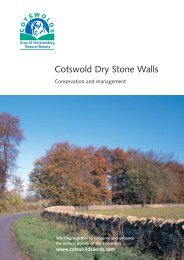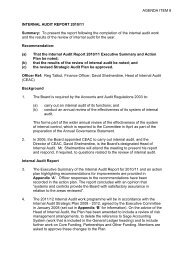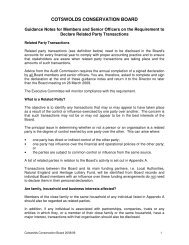AONB LCAR S1 P1-10 FINAL - the Cotswolds Area of Outstanding ...
AONB LCAR S1 P1-10 FINAL - the Cotswolds Area of Outstanding ...
AONB LCAR S1 P1-10 FINAL - the Cotswolds Area of Outstanding ...
You also want an ePaper? Increase the reach of your titles
YUMPU automatically turns print PDFs into web optimized ePapers that Google loves.
2 Evolution <strong>of</strong> <strong>the</strong> Landscape<br />
at Temple Guiting and was probably located adjacent to a<br />
corn mill. Fulling mills were also recorded a few years later<br />
at Bourton-on-<strong>the</strong> Water, Sherbourne, Kingswood and<br />
Wotton-under-Edge indicating <strong>the</strong> expansion <strong>of</strong> <strong>the</strong> cloth<br />
trade in <strong>the</strong> area during <strong>the</strong> medieval period.<br />
2.8.9<br />
Early Modern Period (AD 1500 – 1750)<br />
The largest single event to influence <strong>the</strong> Cotswold<br />
landscape in <strong>the</strong> 16th century was <strong>the</strong> Dissolution <strong>of</strong> <strong>the</strong><br />
Monasteries (1536-1540). Prior to <strong>the</strong> dissolution wealthy<br />
merchants and clothiers who had generated significant<br />
wealth over <strong>the</strong> past century or so in <strong>the</strong> trade <strong>of</strong> undyed<br />
broadcloth, found few means by which to display <strong>the</strong>ir<br />
wealth. However, following <strong>the</strong> dissolution, <strong>the</strong>y were<br />
able to consolidate <strong>the</strong>ir success by <strong>the</strong> acquisition <strong>of</strong> large<br />
tracts <strong>of</strong> land that was formerly owned by <strong>the</strong> monasteries<br />
and build fine new houses, <strong>of</strong>ten from <strong>the</strong> very stones<br />
<strong>of</strong> <strong>the</strong> abbey ruins <strong>the</strong>y had also purchased. They were<br />
also able to establish great parks on <strong>the</strong> lands <strong>the</strong>y had<br />
acquired. This led to <strong>the</strong> first flowering <strong>of</strong> <strong>the</strong> Cotswold<br />
style <strong>of</strong> domestic building.<br />
The period also saw <strong>the</strong> long established land use<br />
traditions <strong>of</strong> <strong>the</strong> past evolve from a subsistence way <strong>of</strong><br />
life to <strong>the</strong> use <strong>of</strong> agriculture as very much more <strong>of</strong> an<br />
economic enterprise. The new class <strong>of</strong> gentry, keen to<br />
increase <strong>the</strong>ir wealth, began to purchase <strong>the</strong> open fields<br />
which <strong>the</strong>y consolidated into single holdings that were<br />
easier to manage and capable <strong>of</strong> generating yet more<br />
wealth. New technologies and methods were embraced<br />
and new crops such as Sanfoin were widely used to raise<br />
production, this being a fodder crop that made it possible<br />
to carry even more sheep on a given area <strong>of</strong> land.<br />
There was a marked increase in <strong>the</strong> extent <strong>of</strong> woodland in<br />
<strong>the</strong> <strong>Cotswolds</strong> during this period. The new mansions and<br />
parks that were springing up across <strong>the</strong> area (estimated to<br />
be at least <strong>10</strong>0 17 ) were planted with trees for shelter, to<br />
line drives, provide fuel and give cover for game. A fine<br />
example is <strong>the</strong> early woodland planting undertaken at<br />
Cirencester Park by Richard Master, physician to Elizabeth<br />
I, which was created on <strong>the</strong> lands previously in <strong>the</strong><br />
ownership <strong>of</strong> Cirencester Abbey.<br />
During <strong>the</strong> 17th century fur<strong>the</strong>r changes occurred in how<br />
<strong>the</strong> rural landscape was farmed and administered. The<br />
ancient rights <strong>of</strong> ‘copyholders’, that is villagers whose right<br />
to hold land was recorded on <strong>the</strong> copyholds held in <strong>the</strong><br />
17. David Verey in Stan Fagg (2003) The Evolution <strong>of</strong> <strong>the</strong> Landscape<br />
<strong>of</strong> <strong>the</strong> <strong>Cotswolds</strong>, Research report for Latham Architects<br />
28<br />
<strong>Cotswolds</strong> <strong>AONB</strong> Partnership<br />
TYPICAL HIGH WOLD ROAD<br />
manor court, were gradually replaced by ‘lifeholds’. In effect<br />
this made farmers tenants who would lease <strong>the</strong> land <strong>the</strong>y<br />
farmed from <strong>the</strong> Lord <strong>of</strong> <strong>the</strong> Manor. Over time, fewer and<br />
fewer tenants farmed larger portions <strong>of</strong> land. It was at this<br />
time that enclosures started in earnest although <strong>the</strong> process<br />
became much accelerated in <strong>the</strong> 18th and 19th centuries.<br />
Prior to enclosure, farming practices had for centuries been<br />
dictated by custom as a result <strong>of</strong> <strong>the</strong> copyhold system which<br />
frustrated farmers who were keen to improve <strong>the</strong> output<br />
<strong>of</strong> <strong>the</strong>ir land. However, Enclosure allowed farmers to<br />
consolidate <strong>the</strong>ir holdings into a single unit and build<br />
farmhouses, <strong>of</strong>ten surrounded by trees to provide shelter<br />
and beautify <strong>the</strong>ir setting. Many shelterbelts were planted<br />
alongside <strong>the</strong> new ‘enclosure roads’ that were built to link<br />
<strong>the</strong> new farms to <strong>the</strong> existing road network. These roads<br />
were specified as being 40ft (12m) wide leaving verges<br />
on ei<strong>the</strong>r side that could be planted with trees or left to<br />
develop naturally into scrub woodland. It is <strong>the</strong>se belts<br />
<strong>of</strong> trees that provided much needed cover on exposed<br />
landscapes such as <strong>the</strong> high wold. Whilst Enclosure proved<br />
beneficial to a minority <strong>of</strong> increasingly wealthy landowners,<br />
<strong>the</strong> landless labourers were thrown into poverty.<br />
2.8.<strong>10</strong><br />
Industrialisation and <strong>the</strong> Modern Period<br />
(AD1750 – 1945)<br />
After 1760 <strong>the</strong> pace <strong>of</strong> enclosure accelerated, effectively<br />
creating <strong>the</strong> patchwork landscape <strong>of</strong> hedged and walled<br />
fields, interspersed with stone farmhouses, that we see<br />
today. The Napoleonic War (1799-1815), and growing<br />
urban populations in <strong>the</strong> ever-expanding industrial cities,<br />
increased <strong>the</strong> demand for food and caused fur<strong>the</strong>r land<br />
to be enclosed. Indeed, between 1800 and 1840, <strong>the</strong> few<br />
remaining open fields and commons were enclosed. In<br />
response to increased demand wealthy landowners became<br />
deeply involved in improving and reorganizing <strong>the</strong>ir farms<br />
in order to maximise efficiency. A number also provided<br />
new cottages in local villages. These cottages were <strong>of</strong>ten<br />
built in <strong>the</strong> traditional style from locally available materials



